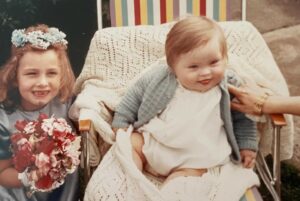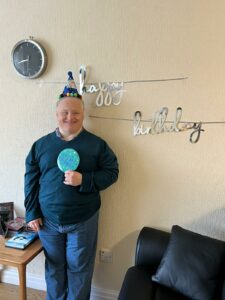
30 Aug 2024
Wherever he went, he made people’s lives better: Gwyn’s story
People with Down’s Syndrome have a significantly higher risk of developing leukaemia. They are about 150 times more likely to develop acute myeloid leukaemia (AML) before the age of four, and 10 to 20 times more likely to develop acute lymphoblastic leukaemia (ALL), compared to children without Downs.[2][3] Children with Downs undergo regular screening for leukaemia in their early years. 2.7% of adults with Downs Syndrome are at an increased risk of developing leukaemia, as opposed to 1.6% of the rest of the adult population – around one and a half times the risk.
Gwyn Jones from Radcliffe in Bury, Greater Manchester, was 56 when he began to show symptoms of fatigue, which were highly unusual for him. He lived in supported housing, and up until that point in his life had been an active man with plenty of friends who enjoyed nothing better than going out and getting together with people.

Gwyn with sister Ann as children
“It was just the two of us with six years between us and I adored my baby brother from the moment he was born,” said Gwyn’s sister Ann, 64, who lives nearby in Prestwich. “We grew up over a shop in South Wales. Mum and Dad ran the business during the daytimes so I would look after him around my school hours, along with my grandmother. I took him everywhere with me and all my friends just accepted him. I did a fundraising ‘Race for Life’ recently in memory of him and many of those friends sponsored me as they said they remembered his hugs and what a big part of our childhood he was.
“Gwyn was born in 1966, before children with learning disabilities had the right to an education. He first went to a type of school which was more like a care setting with care assistants, then after the law changed with the 1970 Education Act, he was taught by qualified teachers. But it was still very different to the type of education he would have had now.
“School, along with our parents, helped him to develop a good level of self-care skills. He was able to communicate verbally and very much enjoyed doing so! He developed some basic literacy skills and food and drink preparation skills, though was never able to be completely independent in the use of the cooker.
“When he was 18, he went to a further education college – and stayed there for years! They loved him there and he made loads of friends, and they put him on course after course – from bricklaying to drama. We used to joke he was their most mature student!”
Ann left home, moved to Manchester, married and had two children, all of which were very much involved in their uncle Gwyn’s life. Gwyn’s parents continued to care for him at home until his father died, and he then moved with his mother to be near Ann in Prestwich.
“She lived until the age of 97 and looked after Gwyn until ten weeks before she passed away – she was ‘old school’ and she felt it was her job to look after Gwyn and nobody else’s. Until her passing, Gwyn had barely spent a night away from her. They adored each other and, as she got older, he would help her more round the house. When I was caring for her at the end, he would get up in the night to help me take her to the toilet – I couldn’t have managed without him.”
By the time Ann’s mother died, Ann was divorced and her grown up children had moved away from home. So initially she moved in with Gwyn to look after him. When they discussed the future, he said he wanted to move as the bungalow he had shared with his mother had too many memories. So, Ann found him a supported accommodation bungalow where he moved in with another friend with learning disabilities. Support workers were present all the time Gwyn was at home to assist him with daily tasks. He lived next door to two women with Down’s Syndrome in another supported bungalow and became good friends with them.
“He loved it there,” said Ann, who is retired from a career as a social worker on a community learning disability team. “They were all good friends and used to go out to ABBA tribute acts and do karaoke together. Singing and dancing was his favourite thing, particularly 70s music – although my mother used to say, ‘God gave him the love of music but not the voice!’
“All was going well for Gwyn, and he had a full and active life. But then at a review with his support manager, she said that carers had reported they were having trouble getting him out of bed in the mornings. This was very unlike Gwyn as previously there had been comments about him getting up too early.”
Ann knew that people with Down’s Syndrome age prematurely so put the tiredness down to this. He had other symptoms of ageing and had been diagnosed with arthritis of the spine which he took painkillers for. When he began complaining about pains in his knees and an X-ray showed some wear and tear of the joints, she put this down to ageing too.
“Looking back, it is hard to know what was actually a leukaemia symptom.”
In July 2023, during a routine blood test, Gwyn’s GP spotted his white blood cell count was high. They rang Ann to say he’d been referred for a haematology appointment.
“I waited for an appointment to come through and, after two months of no news, rang the practice to check that the referral had been made. I was told that it had been and to wait for another month. By October, I had still heard nothing. I rang the GP again and asked which hospital the referral had been sent to. I was told they didn’t know! I tried ringing the local hospitals directly but was told I should try the Referral Centre, as all appointments go through them. I rang the Referral Centre, who told me that the referral had been returned to the GP practice days after it was received, ‘with advice’. I was trying to speak to a doctor at the practice to find out what this meant when Gwyn became ill.
“If I knew then what I know now about the increased risk of leukaemia amongst people with Down’s Syndrome, I would have pushed everyone much harder. But I just didn’t know.”
On 14th November 2022, day centre staff reported to carers that Gwyn had been breathless during the day. Ann visited him at teatime and by which time he was fine. However, at 10pm he rang her to say his heart was going “boom, boom, boom”. This, coupled with his earlier breathlessness, concerned Ann who asked the member of staff on duty at his supported accommodation to ring NHS 111. They said that they would send an ambulance for him, but it would take up to four hours.

Gwyn celebrating his birthday
“I immediately went to his home and took him to hospital. On arrival at A&E at Fairfield Hospital in Bury, he was triaged, sent for an ECG and a blood test. Just over five hours after our arrival in A&E, I was told that it was 99% certain that he had leukaemia. I was completely devastated. The news came as such a shock. It was so unexpected.
“The haematology consultant said if he didn’t have treatment, he would have only three weeks left to live. I was terrified of what was to happen. I was worried that if he had treatment, he would not be able to cope with the side effects, but I was also horrified at the thought we would lose him very soon without treatment.
“I took the decision not to tell Gwyn about his diagnosis. Due to his learning disability, he would not be able to understand fully the implications of a leukaemia diagnosis but would understand enough to be very frightened. Instead, I explained that he had a problem with his blood and that the doctors needed him to stay in hospital to help him to get better.
The following day Gwyn was transferred to the Royal Oldham Hospital’s Haematology Department. After more tests, on 15th November 2022 it was confirmed that Gwyn had Acute Lymphoblastic Leukaemia (ALL). Five days after diagnosis, he was transferred to Manchester Royal Infirmary.
“Treatment could not start immediately. Gwyn was unable to make an informed decision about whether he should have treatment, so we had to have a Best Interests meeting. At the meeting, his wonderful consultant explained what his treatment would look like. She explained that people with Down’s Syndrome can experience more severe side effects but that she could tailor the treatment to suit him.
“At the meeting, we took the decision to go ahead with eight weeks of chemotherapy, but with the proviso that we would review this decision if the side effects appeared too great.”
Treatment began around ten days after Gwyn’s diagnosis.
“Gwyn was very healthy for someone with Down’s and had never been to hospital before. It was so scary for him. But they put him in a private room and brought a bed in for me to stay with him, and let my partner come and go outside of visiting hours. They were very kind.”
Sadly, it very soon became apparent that Gwyn was not going to cope with the side effects of chemotherapy. He was suffering from pains in his hands. He reacted badly to medication given to counteract sickness. Each time he was given this medication, he was unable to communicate verbally though he was aware of his surroundings. He told Ann he felt as if he was in a trance. He had a PICC line to give him chemotherapy and blood transfusions, but he still found treatment distressing.
“After a week or so we held another Best Interests meeting and decided to stop treatment as the side effects were causing him such distress.”
Gwyn was discharged to receive palliative care at home in his supported accommodation bungalow. Ann moved in with him to look after him. After eight weeks at home, with friends visiting him every day, he passed away on 1 February 2023. His funeral was attended by over 150 people.
“He was a wonderful brother and I miss him every day. His happy personality, mischievous spirit and love of people meant he touched the lives of so many in a positive way. He was a born performer, always ready to step up to the mic at any family occasion and sing a song or give a vote of thanks. He lived such a full life – he was a member of a drumming band and a drama group, and he volunteered in the Cancer Research charity shop for 20 years. His social calendar put most peoples to shame. He made friends wherever he went and made people’s lives better. I still visit his friends as it makes me feel still close to him.
“Like many people, before Gwyn was diagnosed I did not know that people with Down’s Syndrome are more likely to develop leukaemia. Since Gwyn died, one of his best friends, who also had Down’s, has also died of leukaemia. I want to share our story in the hope that other families and carers of people with Down’s will be more able to spot symptoms and be aware of the issue.”

Gwyn’s mischievous spirit and love for people spread positivity to everyone he met.
Related posts
11 February 2021
Why I became a Leukaemia UK Trustee
Caroline Evans – Leukaemia UK Trustee and Projects Consultant – reflects on why she became a Trustee and what drives her in the role.
19 December 2023
Beloved actor who beat leukaemia now fronting charity TV ad to help raise vital funds
83-year-old actor Richard Tate will appear on screens from 26th December onwards to support Leukaemia UK’s call for legacy pledges (otherwise known as gifts in Wills), after surviving leukaemia thanks…
10 August 2022
Leukaemia UK unveils an exciting new brand
Leukaemia UK has today revealed a bold new look and feel that embodies the charity’s ambitious new strategy and our desire to be a greater force for change. Bringing together…
6 March 2024
TV baker Juliet Sear announced as Leukaemia UK Ambassador
Leukaemia UK is excited to announce long-time supporter Juliet Sear as their latest celebrity Ambassador. Juliet, who has been an enthusiastic supporter of Leukaemia UK for several years now, wanted…